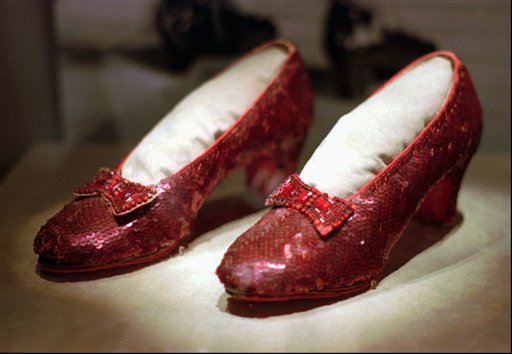
In this April 10, 1996 file photo, the ruby slippers worn by Judy Garland in the 1939 film “The Wizard of Oz” are shown on display during a media tour of the “America’s Smithsonian” exhibition in Kansas City, Mo. (AP Photo/Ed Zurga)
Journalists are suckers for homecoming stories, which is part of the reason the LeBron James story has gained such traction. The essay he wrote for Sports Illustrated with Lee Jenkins is titled “I’m Coming Home,” which is also its final sentence.
I’ve written about the power of the short sentence. It has the ring of gospel truth. Even if there are money and control and competitive issues involved for James, the dominant narrative is that the King, who once lost his way, has now returned… home.
Or has he? What about it, Thomas Wolfe? What about it, Kareem Abdul Jabbar: “LeBron can’t go home again. At least not the home he once knew. They may be grateful and joyful, but they are also wiser. Like the betrayed spouse, they will have to wait and see, they will have to be wooed, they will have to be convinced that his sincerity, to quote Porgy and Bess, ain’t a sometime thing.”
Those of you who read “The Lord of the Rings” trilogy will remember how Frodo Baggins, after destroying the ring of power, returns to his beloved Shire. It’s his best reward, of course, except the Shire is not quite the same, and neither is Frodo.
This pattern, Tolkien called it “there and back,” is so ingrained in the human narrative that we can trace it to the earliest examples of Western literature. What is “The Iliad” except a story about a king leaving the security of his homeland to wage a futile war to regain his faithless queen?
What is “The Odyssey” except a story of how much more difficult it is to return home than to go off to war in the first place.
By the time Odysseus returns to his beloved Ithaca, he finds his house, property, even his wife under siege. Such is his anger that the only remedy is brutal revenge. So much for coming home.
Back then they called it heroism. If it happened today, we’d call it mass murder. When I make this point, I am reminded of a painful fact: that war is still being waged near the land where the Greeks and Trojans battled. We are still sending men and women off to their deaths. We celebrate countless examples of their emotional homecomings. We cry when a child or spouse encircles the beloved warrior with an embrace. We hold aside for a moment that the soldier has returned home without a limb, or that he will be haunted – even to suicide – by the things he has seen.
My attitude to the homecoming story was shaped early by an important American story titled “The Man Without a Country.” Written by Edward Everett Hale and published in The Atlantic in 1863, it was a patriotic allegory at the time of the Civil War. The story involves a young man, Philip Nolan, who becomes involved in an early episode of rebellion against the United States and then curses his country during a court proceeding. He is sentenced to spend his life as a captive on American sailing vessels never able to visit or even hear news of his homeland again.
He becomes a man without a country.
Someone should send a copy of that story to Edward Snowden. The young man who released national security secrets is a hero to some and a traitor to others. His actions have placed him in a kind of phantom zone. He has expressed a desire to return home, but under what terms? A big part of that story, if it ever happens, will be the power of the archetype. The return of the lost son. The homecoming.
“Prefer archetypes to stereotypes,” I wrote in the book Writing Tools. “Use subtle symbols, not crashing cymbals.”
The difference between an archetype and a stereotype is the difference between opening and closing a window. A stereotype limits what we can see. An archetype expands our vision of what a story can be by recognizing that our feelings about LeBron James – and his return as a kind of prodigal son – grows out of our most profound identification with a place: kith and kin, hearth and home.
Let’s plug James into the plot of one of America’s most iconic stories. Think of James as Dorothy. Think of South Beach as Oz. Think of his Nike Elite Laser Crimson basketball shoes as the ruby slippers. Think of Ohio as Kansas. There’s no place like home.









Comments